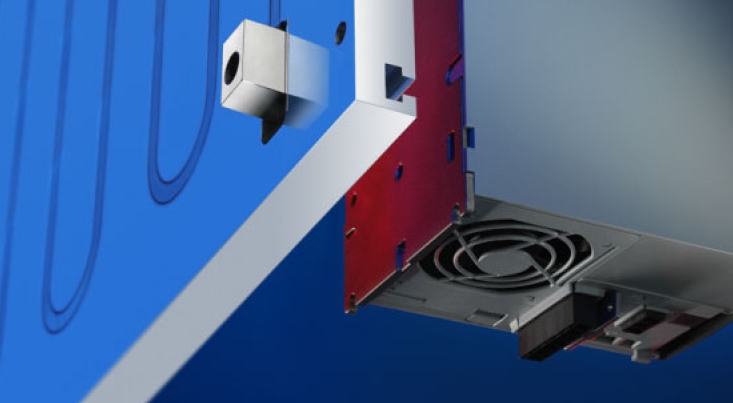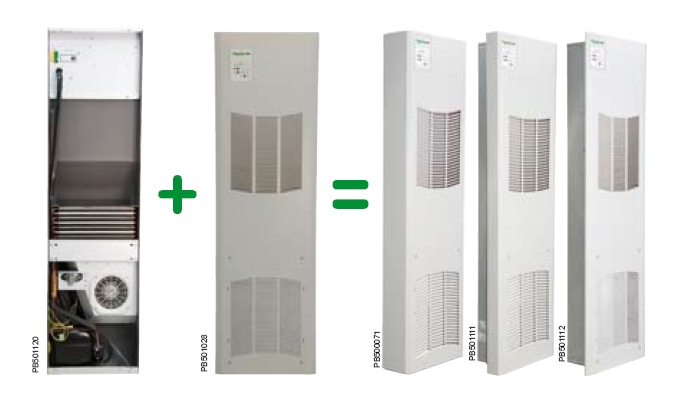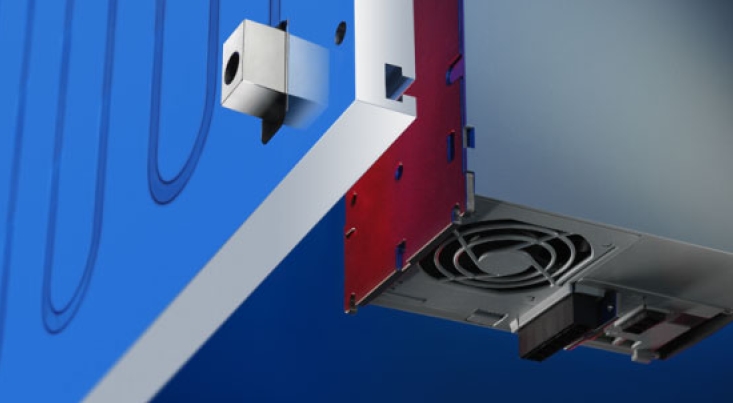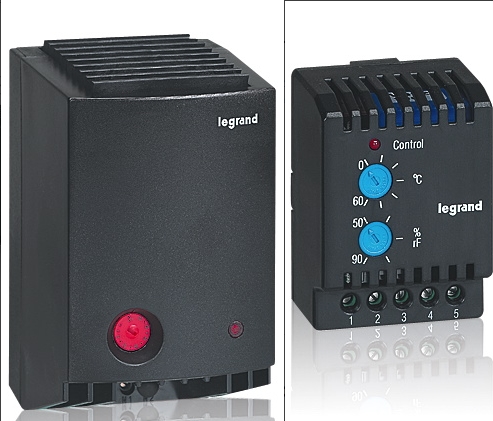
Fighting against the cold
Fighting against the cold temperature when switchboards are outdoors or in unheated rooms shouldn’t be the only goal: the condensation risk constitutes a major danger for electronic devices. Corrosion, oxidation, or bad contacts are phenomena that have to be avoided. This condensation is often the result of alternation between warming and cooling (day/night cycle for example). So, there are heating resistances (at a voltage of 12 to 450V AC/DC) controlled by thermostats according to a temperature value and/or by a hygrostat according to a relative humidity point. In large size electrical switchboards, it is recommended to use many low power heating resistances instead of just one high power resistance, in order to obtain an even distribution of the heat along the switchboard. Furthermore, it is usually advised to use heating resistances in addition to heat exchangers or conditioners to avoid condensation.
Avoid overheating
During the design phase, and when choosing the layout of the devices in the switchboard, it is important to take care of the proper positioning of the more exothermic devices. Their location has a huge impact, to optimize their cooling by natural convection (natural displacement of the air masses inside the enclosure), and to prevent that the heat they dissipate may provoke the overheating of the other devices, in particular the most sensitive ones. If, despite that, the heating risk stays too high, it is necessary to consider complementary measures to lower the temperature. A number of solutions are available:
–First approach: Would a simple fan be enough to evacuate the excess of heat dissipated?
Using fan and filters is an extremely cost-effective method to evacuate large quantities of heat dissipated out of the electrical switchboard. Anyway, they can only be used under two necessary conditions: the switchboard’s external ambient atmosphere must not be too polluted and the external temperature has to remain much lower than the switchboard’s internal temperature. Last thing, the fan and filter unit must integrate an EMC protection when the devices inside the switchboard require EMC protection.
–When the air, out of the switchboard, is too polluted to use fans, the air/air exchanger enables a thermal exchange without contact between flows. This means that the external dust cannot enter inside the switchboard. However, the difference between the external and the internal switchboard’s temperature impacts directly the quantity of heat dissipated that can be evacuated. The calorific power of that kind of system is defined in W/°C.
–When the external temperature stays too high to enable a simple thermal exchange, then it becomes necessary to use a cooling unit or an available refrigerating source. Hence a solution with an air/water thermal exchanger has to be used along with a central cooling unit or a cooling water circuit. This solution, quite heavy, is generally only considered for a minimum number of switchboards to cool down.
-More autonomous is the enclosure cooling unit (enclosure air conditioner) which makes it possible to cool individually the atmosphere of every enclosures’ closed compartments. This thermodynamics solution offers a pretty high efficiency level.

With 4 levels of power, 3 kinds of supply voltages and different casings adapted for electrical enclosures, Schneider Electric offers a range of 66 models of enclosures’ air conditioners from 1.1 to 2.7kW. Source: Schneider Electric
Switchboard manufacturers integrate these enclosure cooling units inside or outside the switchboards enclosure (in the thickness of the door, on the side or even on top the enclosure). A connection to a door switch enables to stop it when the door is opened, and a restarting with a timer. Condensation water is automatically evacuated.
-There are finally some clever solutions which enable to evacuate the heat dissipated at its source. As such, some enclosure manufacturers offer to install variable speed drives through the back of the enclosure, so that the VSD radiator evacuates the calories directly outside of the switchboard.

Direct cooling at the heat dissipation source is a developing trend. Rittal offers a “cold” mounting plate, cooled by a liquid circulation. Source: Rittal
Adding a fan on this external radiator improves the efficiency of this configuration. Other solution: to install, at the source of the heat dissipation, a special mounting plate cooled by a serpentine integrated at its rear face, with cold water provided by an external source.
For the most exothermic devices, the trend is to control the heat dissipation at its source. Think also about the computer servers’ domain, where manufacturers go up to the direct cooling of the microprocessors with a liquid exchanger!

I really know much about electronics but I do hope that in the future, electronic devices will have its own cooling system.
Agree with the above comment! It seems that we are working to hard to produce a secondary device that should already have some sort of integration in the primary system.
I feel like the best combination would involve both the primary and secondary device. Each one functions as the others’ backup.